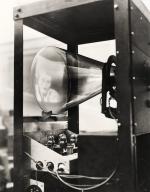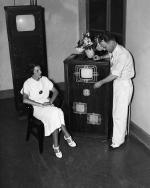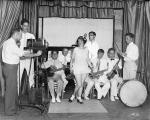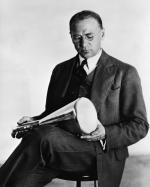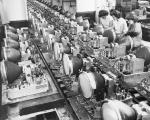![header=[Marker Text] body=[Inventor of electronic television, he led some of the first experiments in live local TV broad-casting in the late 1930s from his station W3XPF located on this site. A pioneer in electronics, Farnsworth held many patents and was inducted into the Inventors Hall of Fame. ] sign](http://explorepahistory.com/kora/files/1/10/1-A-3A6-139-ExplorePAHistory-a0m4t9-a_450.jpg)
Mouse over for marker text
Name:
Philo T. Farnsworth (1906-1971)
Region:
Philadelphia and its Countryside/Lehigh Valley
County:
Montgomery
Marker Location:
1260 E Mermaid Lane, Wyndmoor
Dedication Date:
September 15, 2006
Behind the Marker
In June 1931, Philo T Farnsworth, the first man to successfully transmit an image using an electrical system free of moving parts, left his Green Street Laboratories in San Francisco to work for the Philco Storage Battery Company in Philadelphia, Pa. Philco, since the early 1920s, had battled with the Westinghouse Electric Corporation and Atwater Kent as the nation's largest radio manufacturers. With the hiring of Farnsworth, Philco took a major step in the race to develop a viable technology for the transmission of moving images.
Farnsworth, then just twenty-five years old, was the man to hire. Born in Utah and raised in Rigby, Idaho, he, at the age of fourteen, had developed the concept for an all-electrical television. When Farnsworth was twenty, a group of investors had set him up in San Francisco to work on his electronic television system, and there, in September 1927, he had transmitted his first image, a simple line, from one room in his laboratory to another. Later that year, Farnsworth filed for his first patent.
Unable to find a buyer for the patent, Farnsworth and his investors struck the deal with Philco that brought the young inventor to Philadelphia. Philco would foot the bill for Farnsworth's experiments. In return, Farnsworth would grant Philco a license to manufacture television receivers and help the company establish a station for television broadcast.
The arrangement, however, quickly soured. Farnsworth continued his work to improve the image quality of his transmitter and helped establish Philco's experimental television station, W3XE, but Philco soon chafed at the expense and slow progress of his research and the informal West Coast work style of Farnsworth and his crew. After two years, they had tired of financing Farnsworth without owning any of his patent rights. The company was also getting pressured by the Radio Corporation of America (RCA), also working on the development of television, which delivered an ultimatum: Get rid of Farnsworth or lose the RCA patent licenses needed for the production of radios. So, in 1933, Farnsworth left Philco and set up his own company, Farnsworth Television, at 127 East Mermaid Lane, in Philadelphia.
In the summer of 1934, Farnsworth staged the first public display of his television system at Philadelphia's Franklin Institute. Over the next three weeks, he treated his audience to musical performances, vaudeville acts, speeches by dignitaries, and trained animal acts. He set up a camera at the exhibit's entrance so that members of the excited crowds, the lines often stretching around the outside of the building, could see them own images transmitted to a television receiver just inside the door. In two weeks, Farnsworth's television exhibit took in more money than the Institute had received from admissions in the past two years.
Following his success at the Franklin Institute, Farnsworth set up his own television broadcasting station. Farnsworth's crew built a special transmitter and a 100-foot tower in Wyndmoor that blanketed the Philadelphia metropolitan area with television signals and designed and built the world's first electronic video switcher, which allowed instantaneous inter-cutting between two cameras during program broadcasts. In 1937, the FCC granted Farnsworth a license to conduct experimental television transmissions under the call letters W3XPF. From 1937 to 1939, a stream of cartoons, sports, and live entertainment poured from the station transmitter to about fifty television sets throughout Philadelphia. His success, however, was not to last.
In the race to develop viable television systems, Farnsworth had powerful competitors. Westinghouse had entered the race to develop television in 1919 when it hired Russian engineer Vladimir Zworykin, who in 1923 filed groundbreaking patents for two patent applications, the first, titled "Television Systems." Zworykin's system, however, like those being developed in England by John Logie Baird, and by engineers at Bell Telephone Labs and AT&T relied upon the Nipkow Disk, a mechanical image-scanning system whose spinning disk produced only a poor and fuzzy image. In the 1929, Zworykin and his staff moved from Pittsburgh to the RCA facilities in Camden, N.J. It was Farnsworth, however, who held the essential patents that RCA needed. Rather than rely on a spinning disk, Farnsworth used a cathode ray tube to break the image down into higher resolution electrical signals.
To force Farnsworth to sell his patents, RCA in 1934 initiated the same sort of patent claims against him that it had used to destroy dozens of similar fledgling companies. "The RCA doesn't pay patent royalties," RCA General Manager Sarnoff famously declared. "We collect them." Even after a July 1935 court ruling that Farnsworth's television system had priority of invention over RCA's Zworykin model, the dispute dragged on for four more years, sapping Farnsworth's capital and his energy.
To make money until television became commercially viable, the Farnsworth Television and Radio Corporation bought a radio manufacturer in Fort Wayne, Ind. In the fall of 1939, Farnsworth packed his lab and left Philadelphia for Fort Wayne, and then settled with RCA, which agreed to pay him $1 million and ongoing royalties on every television set it sold.
Using Farnsworth designs, Philco also continued in the television business. In 1940, Philco television station W3XE broadcast its first Penn football game to about 700 television sets in the Philadelphia area. Philco would operate the station until 1953, when it sold it to Westinghouse. Following World War II, the television industry began to boom. In 1949, Philco produced 800,000 sets and still had trouble meeting orders. The company would continue to produce sets until it was bought by Ford in 1961.
After settling with RCA, Farnsworth never reaped his fair share of the enormous profits his invention brought to so many. Three million dollars earned from the sale of his remaining television patents proved insufficient to cover his debts of his Fort Wayne Company. In spring 1949, International Telephone and Telegraph Corporation (ITT) bought Farnsworth Television, with the stipulation that Farnsworth remain with the company as vice president of research. He retired from ITT in 1966 and moved back to Utah.
In his later years, Farnsworth worked on a nuclear-fusion process to produce clean, unlimited energy, and held two fusion-energy patents. When he died from emphysema at age sixty-four in 1971, Philo T. Farnsworth held more than 300 U.S. and foreign patents. In 1983 he became one of the first four inventors honored by the U.S. Postal Service with a stamp bearing his portrait.
"There's nothing on it worthwhile, and we're not going to watch it in this household, and I don't want it in your intellectual diet."
Comment made by television pioneer Philo T. Farnsworth to his son in 1953.
In June 1931, Philo T Farnsworth, the first man to successfully transmit an image using an electrical system free of moving parts, left his Green Street Laboratories in San Francisco to work for the Philco Storage Battery Company in Philadelphia, Pa. Philco, since the early 1920s, had battled with the Westinghouse Electric Corporation and Atwater Kent as the nation's largest radio manufacturers. With the hiring of Farnsworth, Philco took a major step in the race to develop a viable technology for the transmission of moving images.
Farnsworth, then just twenty-five years old, was the man to hire. Born in Utah and raised in Rigby, Idaho, he, at the age of fourteen, had developed the concept for an all-electrical television. When Farnsworth was twenty, a group of investors had set him up in San Francisco to work on his electronic television system, and there, in September 1927, he had transmitted his first image, a simple line, from one room in his laboratory to another. Later that year, Farnsworth filed for his first patent.
Unable to find a buyer for the patent, Farnsworth and his investors struck the deal with Philco that brought the young inventor to Philadelphia. Philco would foot the bill for Farnsworth's experiments. In return, Farnsworth would grant Philco a license to manufacture television receivers and help the company establish a station for television broadcast.
The arrangement, however, quickly soured. Farnsworth continued his work to improve the image quality of his transmitter and helped establish Philco's experimental television station, W3XE, but Philco soon chafed at the expense and slow progress of his research and the informal West Coast work style of Farnsworth and his crew. After two years, they had tired of financing Farnsworth without owning any of his patent rights. The company was also getting pressured by the Radio Corporation of America (RCA), also working on the development of television, which delivered an ultimatum: Get rid of Farnsworth or lose the RCA patent licenses needed for the production of radios. So, in 1933, Farnsworth left Philco and set up his own company, Farnsworth Television, at 127 East Mermaid Lane, in Philadelphia.
In the summer of 1934, Farnsworth staged the first public display of his television system at Philadelphia's Franklin Institute. Over the next three weeks, he treated his audience to musical performances, vaudeville acts, speeches by dignitaries, and trained animal acts. He set up a camera at the exhibit's entrance so that members of the excited crowds, the lines often stretching around the outside of the building, could see them own images transmitted to a television receiver just inside the door. In two weeks, Farnsworth's television exhibit took in more money than the Institute had received from admissions in the past two years.
Following his success at the Franklin Institute, Farnsworth set up his own television broadcasting station. Farnsworth's crew built a special transmitter and a 100-foot tower in Wyndmoor that blanketed the Philadelphia metropolitan area with television signals and designed and built the world's first electronic video switcher, which allowed instantaneous inter-cutting between two cameras during program broadcasts. In 1937, the FCC granted Farnsworth a license to conduct experimental television transmissions under the call letters W3XPF. From 1937 to 1939, a stream of cartoons, sports, and live entertainment poured from the station transmitter to about fifty television sets throughout Philadelphia. His success, however, was not to last.
In the race to develop viable television systems, Farnsworth had powerful competitors. Westinghouse had entered the race to develop television in 1919 when it hired Russian engineer Vladimir Zworykin, who in 1923 filed groundbreaking patents for two patent applications, the first, titled "Television Systems." Zworykin's system, however, like those being developed in England by John Logie Baird, and by engineers at Bell Telephone Labs and AT&T relied upon the Nipkow Disk, a mechanical image-scanning system whose spinning disk produced only a poor and fuzzy image. In the 1929, Zworykin and his staff moved from Pittsburgh to the RCA facilities in Camden, N.J. It was Farnsworth, however, who held the essential patents that RCA needed. Rather than rely on a spinning disk, Farnsworth used a cathode ray tube to break the image down into higher resolution electrical signals.
To force Farnsworth to sell his patents, RCA in 1934 initiated the same sort of patent claims against him that it had used to destroy dozens of similar fledgling companies. "The RCA doesn't pay patent royalties," RCA General Manager Sarnoff famously declared. "We collect them." Even after a July 1935 court ruling that Farnsworth's television system had priority of invention over RCA's Zworykin model, the dispute dragged on for four more years, sapping Farnsworth's capital and his energy.
To make money until television became commercially viable, the Farnsworth Television and Radio Corporation bought a radio manufacturer in Fort Wayne, Ind. In the fall of 1939, Farnsworth packed his lab and left Philadelphia for Fort Wayne, and then settled with RCA, which agreed to pay him $1 million and ongoing royalties on every television set it sold.
Using Farnsworth designs, Philco also continued in the television business. In 1940, Philco television station W3XE broadcast its first Penn football game to about 700 television sets in the Philadelphia area. Philco would operate the station until 1953, when it sold it to Westinghouse. Following World War II, the television industry began to boom. In 1949, Philco produced 800,000 sets and still had trouble meeting orders. The company would continue to produce sets until it was bought by Ford in 1961.
After settling with RCA, Farnsworth never reaped his fair share of the enormous profits his invention brought to so many. Three million dollars earned from the sale of his remaining television patents proved insufficient to cover his debts of his Fort Wayne Company. In spring 1949, International Telephone and Telegraph Corporation (ITT) bought Farnsworth Television, with the stipulation that Farnsworth remain with the company as vice president of research. He retired from ITT in 1966 and moved back to Utah.
In his later years, Farnsworth worked on a nuclear-fusion process to produce clean, unlimited energy, and held two fusion-energy patents. When he died from emphysema at age sixty-four in 1971, Philo T. Farnsworth held more than 300 U.S. and foreign patents. In 1983 he became one of the first four inventors honored by the U.S. Postal Service with a stamp bearing his portrait.





